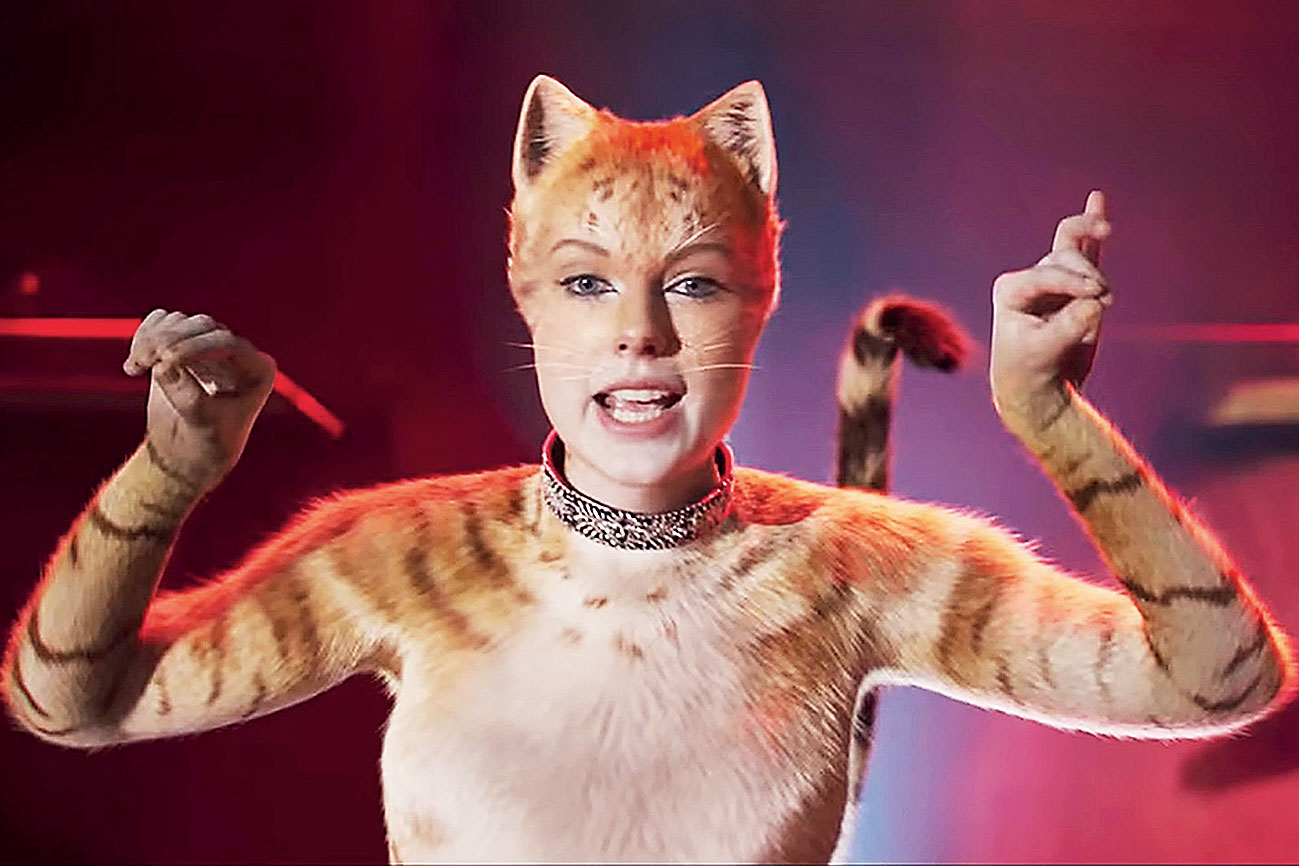It is tough to pinpoint when the kitschapalooza called Cats reaches its zenith or its nadir, which are one and the same. The choices are legion: Judi Dench gliding in as Old Deuteronomy, a Yoda-esque fluff ball with a huge ruff who brings to mind the Cowardly Lion en route to a drag ball as Queen Elizabeth I; the tap dancing Skimbleshanks (Steven McRae), dressed, unlike most of the furries - in red pants and suspenders, no less — leading a Pied Piper parade; or Taylor Swift, as Bombalurina, executing a joyless burlesque shimmy after descending on the scene astride a crescent moon that ejaculates iridescent catnip.
I could go on and must go on — yet how to explain the seemingly unexplainable, beginning with a narrative and language that borders on the gnomic? A doctoral thesis could be written on how this misfire sputtered into existence, though there’s nothing new about the movies’ energetic embrace of bad taste. One problem is that Cats was directed by Tom Hooper, a well-behaved journeyman (The King’s Speech), who is nowhere near vulgar enough for the challenge he was hired for, which is to translate Andrew Lloyd Webber’s money-printing musical to the big screen.
Certainly Hooper has made a robust effort, as suggested by all the busy leaping, pirouetting, stretching, caterwauling and meowing. To help make the transition to the screen he’s enlisted some talented performers to slink and sing, including Francesca Hayward, a principal dancer for the Royal Ballet making her movie debut as Victoria. The original musical involves a clowder of cats with its own lingo (“Jellicle”) that convenes on the night one is chosen to be reborn. This cat Christ element remains in the movie, which was written by Hooper and Lee Hall. But now the focus has shifted to Victoria, an abandoned kitty who sets off on a heroic journey amid swishing tails, bumping heads and hisses.
The genesis for the movie stretches back to the 1970s when Lloyd Webber began adapting T.S. Eliot’s Old Possum’s Book of Practical Cats for the stage. First published in 1939, Old Possum’s is a collection of poems about cats with names like Growltiger, Mungojerrie and Rumpleteazer. The poems are often described as whimsical, but if they’re not your cup of twee they can grate. It was Ezra Pound, calling himself Brer Rabbit, who gave Eliot the nickname Old Possum, another moniker borrowed from Joel Chandler Harris’s Uncle Remus collection of African-American folklore. Eliot and Pound apparently liked writing to each other in the dialect used in Remus, in a kind of literary minstrelsy.
For his Cats, Lloyd Webber mostly set Eliot’s light verse to music. Trevor Nunn, who directed the original London production in 1981, provided lyrics for the show’s most famous tear-duct pumper, Memory, sung by a forlorn outcast, Grizabella. A badly served Jennifer Hudson, cowering and belting with rivers of tears and snot, plays this mangy-looking stray in furs, who here suggests a Park Avenue pet terminally down on her luck. (Nunn’s inspiration was Eliot’s beautiful Rhapsody on a Windy Night, a non-Possum poem, which reads in part: “Remark the cat which flattens itself in the gutter/Slips out its tongue/And devours a morsel of rancid butter.”)
Transposing Cats to the screen was always going to be difficult, particularly once the decision was made to create a live-action version rather than an animated one. Traditional theatre depends on the viewer’s going along with a very delicate balance of reality and unreality that comes when viewers breathe the same air and share the same space as live actors; movies create a different reality effect or, if you insist, magic. Part of the pleasure of theatre (if you’re a partisan) is this human factor. But without the presence of hard-working troupers in fun fur in this Cats, all that’s left are canned images of fit-looking people meowing and raising their rumps high in the air.
The bobbing butts have their obvious appeal. But Hooper’s mistake is that he’s tried to class up the joint. What a blunder! In feline terms, this is a movie without epic hairballs, without rear-end sniffing, without a deep, wounding scratch. Instead the movie tamps down and tidies its innate strangeness, cutting carefully loose only in its more comic numbers. By far the best in show in this respect are James Corden, wittily frolicking amid trash as Bustopher Jones; and Rebel Wilson, whose spoiled Jennyanydots leads a Busby Berkeleyesque jaw-dropper with a warbling (quavering) company of mice and a parade of high-stepping, kaleidoscopically trained cockroaches.
Generally, Hooper pulls away from loony-tunes excess, tries for sexy rather than freaky, and plucks at heartstrings, a reflex that pulls the story into mawkishness, particularly when he cuts to Victoria. Hayward is a lovely, supple dancer, who brings some depth to her character purely through movement. Here, though, her face mostly conveys blurred yearning and all those close-ups suggest a director struggling to get more from an actor. It’s too bad that no one seems to have thought through the semiotics of Victoria’s chalky white cat face, given that Hayward is of mixed race and that the heavy is Idris Elba’s predatory Macavity. Elba seems to be having a fine time, but come on!











